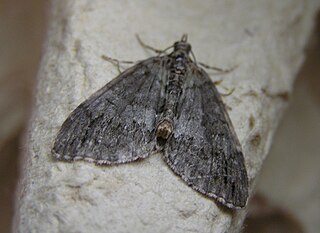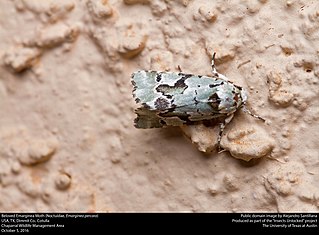
Hydriomena is a genus of moths in the family Geometridae described by Hübner in 1825.
Hymenodria is a monotypic moth genus in the family Geometridae erected by James Halliday McDunnough in 1954. Its only species, Hymenodria mediodentata, was first described by William Barnes and McDunnough in 1911. It is found in North America.
Acroncosa is a genus of snout moths in the subfamily Phycitinae. It was described by William Barnes and James Halliday McDunnough in 1917. The type species is Acroncosa albiflavella.

Cahela is a monotypic snout moth genus described by Carl Heinrich in 1939. Its only species, Cahela ponderosella, the cahela moth, described by William Barnes and James Halliday McDunnough in 1918, is found in Mexico and in the US states of California, Texas, Arizona, Utah and probably Nevada.
Cacotherapia angulalis is a species of snout moth in the genus Cacotherapia. It was described by William Barnes and James Halliday McDunnough in 1918 and is known from the US state of California.
Cacotherapia bilinealis is a species of snout moth in the genus Cacotherapia. It was described by William Barnes and James Halliday McDunnough in 1918 and is known from the US state of Arizona.
Cacotherapia unicoloralis is a species of snout moth in the genus Cacotherapia. It was described by William Barnes and James Halliday McDunnough in 1913 and is known from the US state of Florida.
Coenochroa bipunctella, the sand dune panic grass moth, is a species of snout moth in the genus Coenochroa. It was described by William Barnes and James Halliday McDunnough in 1913, and is known from the United States, including Florida, Arizona and Maryland.
Echinocereta is a monotypic snout moth genus described by Herbert H. Neunzig in 1997. The genus contains only one species, Echinocereta strigalis, described by William Barnes and James Halliday McDunnough in 1912, which is found in the US states of Arizona, California, Texas, Utah and in Mexico.
Acroncosa similella is a species of snout moth in the genus Acroncosa. It was described by William Barnes and James Halliday McDunnough in 1917. It is found in the US state of California.
Anemosella viridalis is a species of snout moth in the genus Anemosella. It was described by William Barnes and James Halliday McDunnough in 1912, and is known from Mexico and the US state of Arizona.
Chararica bicolorella is a species of snout moth in the genus Chararica. It was described by William Barnes and James Halliday McDunnough in 1917. It is found in the US states of California and Arizona.
Negalasa is a monotypic snout moth genus described by William Barnes and James Halliday McDunnough in 1913. Its one species, Negalasa fumalis, was described by Barnes and McDunnough in the same paper. It is found in North America, including Arizona.
Crambidia suffusa is a moth of the family Erebidae. It was described by William Barnes and James Halliday McDunnough in 1912. It is found in the US state of California.
Cisthene conjuncta, the white-streaked lichen moth, is a moth of the family Erebidae. It was described by William Barnes and James Halliday McDunnough in 1913. It is found in southern Texas.
Cisthene picta, the pictured lichen moth, is a moth of the family Erebidae. It was described by William Barnes and James Halliday McDunnough in 1918. It is found in the United States from Texas to Arizona. The habitat consists of deserts.
Cisthene subrufa, the Tamaulipan lichen moth, is a moth of the family Erebidae. It was described by William Barnes and James Halliday McDunnough in 1913. It is found in the United States in Arizona and from San Benito, Texas south to Veracruz in Mexico.
Stiriini is a tribe of owlet moths in the family Noctuidae. There are at least 120 described species in Stiriini.

Psaphidini is a tribe of owlet moths in the family Noctuidae. There are at least 40 genera and at least 90 described species in Psaphidini.
Chalcopasta fulgens is a species of owlet moth in the family Noctuidae. It was described by William Barnes and James Halliday McDunnough in 1912 and is found in North America.



